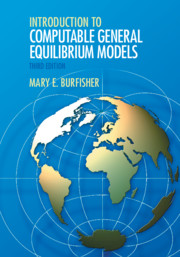Book contents
- Introduction to Computable General Equilibrium Models
- Introduction to Computable General Equilibrium Models
- Copyright page
- Dedication
- Contents
- Figures
- Tables
- Text Boxes
- Acknowledgments
- About This Book
- 1 Introduction to Computable General Equilibrium Models
- 2 Elements of a Computable General Equilibrium Model
- 3 The CGE Model Database
- 4 Final Demand in a CGE Model
- 5 Supply in a CGE Model
- 6 Factors of Production in a CGE Model
- 7 Trade in a CGE Model
- 8 Taxes in a CGE Model
- 9 Regulations in a CGE Model
- 10 Conclusion
- Model Exercises
- Practice and Review Answer Key
- Model Exercise Answer Key
- Book part
- Glossary
- References
- Author Index
- Subject Index
7 - Trade in a CGE Model
Published online by Cambridge University Press: 11 December 2020
- Introduction to Computable General Equilibrium Models
- Introduction to Computable General Equilibrium Models
- Copyright page
- Dedication
- Contents
- Figures
- Tables
- Text Boxes
- Acknowledgments
- About This Book
- 1 Introduction to Computable General Equilibrium Models
- 2 Elements of a Computable General Equilibrium Model
- 3 The CGE Model Database
- 4 Final Demand in a CGE Model
- 5 Supply in a CGE Model
- 6 Factors of Production in a CGE Model
- 7 Trade in a CGE Model
- 8 Taxes in a CGE Model
- 9 Regulations in a CGE Model
- 10 Conclusion
- Model Exercises
- Practice and Review Answer Key
- Model Exercise Answer Key
- Book part
- Glossary
- References
- Author Index
- Subject Index
Summary
In this chapter, we present the building blocks for trade policy analysis using a computable general equilibrium (CGE) model. We begin by reviewing the trade data in the Social Accounting Matrix (SAM). Next, we introduce two concepts, the real exchange rate and terms of trade, and explain how they are represented in standard CGE models. We then focus on trade theory as we simulate and interpret the results of two types of shocks: a change in factor endowments that change comparative advantage, and a change in world prices that changes industry structure, trade, and factor returns. We study an example of “Dutch Disease,” a problem that illustrates the links between a change in world prices, the real exchange rate, and industry structure. We conclude with an explanation of the role of trade margin costs in international trade.
Keywords
- Type
- Chapter
- Information
- Introduction to Computable General Equilibrium Models , pp. 194 - 218Publisher: Cambridge University PressPrint publication year: 2021

